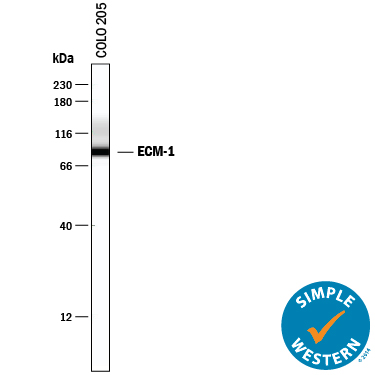Human ECM1 Antibody Summary
Ala20-Glu540
Accession # AAH23505
Applications
Please Note: Optimal dilutions should be determined by each laboratory for each application. General Protocols are available in the Technical Information section on our website.
Scientific Data
 View Larger
View Larger
Detection of Human ECM‑1 by Western Blot. Western blot shows lysates of COLO 205 human colorectal adenocarcinoma cell line and SK-Mel-28 human malignant melanoma cell line. PVDF membrane was probed with 1 µg/mL of Sheep Anti-Human ECM-1 Antigen Affinity-purified Polyclonal Antibody (Catalog # AF3937) followed by HRP-conjugated Anti-Sheep IgG Secondary Antibody (Catalog # HAF016). A specific band was detected for ECM-1 at approximately 75 kDa (as indicated). This experiment was conducted under reducing conditions and using Immunoblot Buffer Group 1.
 View Larger
View Larger
ECM‑1 in Human Colon Cancer Tissue. ECM‑1 was detected in immersion fixed paraffin-embedded sections of human colon cancer tissue using 15 µg/mL Sheep Anti-Human ECM‑1 Antigen Affinity-purified Polyclonal Antibody (Catalog # AF3937) overnight at 4 °C. Tissue was stained with the Anti-Sheep HRP-DAB Cell & Tissue Staining Kit (brown; Catalog # CTS019) and counterstained with hematoxylin (blue). Specific labeling was localized to the plasma membrane of epithelial cells. Lower panel shows a lack of labeling if primary antibodies are omitted and tissue is stained only with secondary antibody followed by incubation with detection reagents. View our protocol for Chromogenic IHC Staining of Paraffin-embedded Tissue Sections.
 View Larger
View Larger
Detection of Human ECM‑1 by Simple WesternTM. Simple Western lane view shows lysates of COLO 205 human colorectal adenocarcinoma cell line, loaded at 0.2 mg/mL. A specific band was detected for ECM-1 at approximately 90 kDa (as indicated) using 10 µg/mL of Sheep Anti-Human ECM-1 Antigen Affinity-purified Polyclonal Antibody (Catalog # AF3937) followed by 1:50 dilution of HRP-conjugated Anti-Sheep IgG Secondary Antibody (Catalog # HAF016). This experiment was conducted under reducing conditions and using the 12-230 kDa separation system.
Reconstitution Calculator
Preparation and Storage
- 12 months from date of receipt, -20 to -70 °C as supplied.
- 1 month, 2 to 8 °C under sterile conditions after reconstitution.
- 6 months, -20 to -70 °C under sterile conditions after reconstitution.
Background: ECM1
Extracellular matrix protein-1 (ECM-1) is an 85 kDa, secreted glycoprotein important in connective tissue organization (1‑3). Of three identified splice variants the 540 amino acid (aa) form, ECM-1a, is the most widely expressed, with the highest expression in the placenta and heart (2). ECM-1b (415 aa) is found only in tonsil and associated with suprabasal keratinocytes (2, 4). Since ECM-1b expression is differentiation-dependent, a role in terminal keratinocyte differentiation has been suggested (4). ECM-1c (559 aa) accounts for approximately 15% of skin ECM-1 (5). Human ECM-1a contains a 19 aa signal peptide and a 521 aa secreted portion that includes an N-terminal proline-rich, cysteine-free region, two tandem repeat domains, and a C-terminal domain. There are six repeats of a CC(X7 ‑10)C motif (x = any aa) within the tandem repeat and C‑terminal domains. These motifs are involved in ligand binding to members of the albumin family, and are expected to form two (in ECM-1b) or three (in ECM-1a) “double loop” structures (2). Mature human ECM-1a shows 69%, 71%, 72%, and 76% aa identity with corresponding isoforms of mouse, rat, canine, and bovine ECM-1, respectively. ECM-1 is over-expressed in many malignant epithelial tumors and has demonstrated angiogenic activity (6, 7). A variety of ECM-1 mutations, mainly within the first tandem repeat, are considered causative of lipoid proteinosis, a condition showing thickened and irregular extracellular matrix within connective tissue (8). In the autoimmune condition lichen sclerosis, auto-antibodies mainly recognize the second tandem repeat or the C-terminus of ECM-1 (9). These domains also bind the extracellular matrix molecules fibulin-1 and perlecan (5, 10). The phenotypes of lipoid proteinosis and lichen sclerosis support a role for ECM-1 as a “biological glue” in the dermis (1).
- Chan, I. (2004) Exp. Dermatol. 29:52.
- Smits, P. et al. (1997) Genomics 45:487.
- Bhalerao, J. et al. (1995) J. Biol. Chem 270:16385.
- Smits, P. et al. (2000) J. Invest. Dermatol. 114:718.
- Mongiat, M. et al. (2003) J. Biol. Chem. 278:17491.
- Han, Z. et al. (2001) FASEB J. 15:988.
- Wang, L. et al. (2003) Cancer Lett. 200:57.
- Hamada, T. et al. (2003) J. Invest. Dermatol. 120:345.
- Oyama, N. et al. (2004) J. Clin. Invest. 113:1550.
- Fujimoto, N. et al. (2005) Biochem. Biophys. Res. Commun. 333:1327.
Product Datasheets
FAQs
No product specific FAQs exist for this product, however you may
View all Antibody FAQsReviews for Human ECM1 Antibody
There are currently no reviews for this product. Be the first to review Human ECM1 Antibody and earn rewards!
Have you used Human ECM1 Antibody?
Submit a review and receive an Amazon gift card.
$25/€18/£15/$25CAN/¥75 Yuan/¥2500 Yen for a review with an image
$10/€7/£6/$10 CAD/¥70 Yuan/¥1110 Yen for a review without an image

